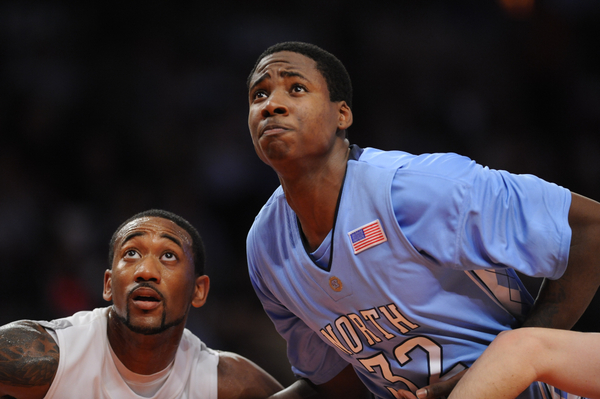RTC NBA Draft Profiles: Ed Davis
Posted by rtmsf on June 20th, 2010Player Name: Ed Davis
School: North Carolina
Height/Weight: 6’9, 227
NBA Position: Power Forward
Projected Draft Range: Late lottery
Overview: At one point, Ed Davis was seen as a top-five, even top-three, draft pick. While Davis is still a likely lottery pick, his stock has fallen since that time. After winning a national championship with the Tar Heels as a freshman (and adding 11 points and eight rebounds in just 14 minutes in the national championship game), last season had to be major disappointment for Davis. Aside from his team’s season-long struggles, Davis’ season was also ended early, following a broken left wrist, even more of a problem given that Davis is a lefty. Davis was dominant for stretches (he had a 12-game streak from late November to early January where he averaged 17.2 ppg, 11.1 rpg and 3 bpg), but was inconsistent at times, often due to his raw offensive game. Perhaps some of Davis’s struggles can be attributed to less-than-stellar guard play on the Carolina squad, but he does still have plenty of work to do on his game before he can live up to his potential as a definite prospect.
Will Translate to the NBA: Davis’ listed height is a little on the small side for an NBA power forward, but his 7’0 wingspan and bouncy athleticism more than makes up for the lack of an inch or two. Davis uses his great length to clean the glass on both ends of the floor very effectively, and his work on the offensive glass is one of the strong points of his offensive game, as he is an excellent finisher inside. Davis is also a terrific on help defense, coming over from the weak side to block a ton of shots. He possesses good quick footwork for a man his size, capable of defending face-up and perimeter power forwards through his combination of lateral quickness, length and hard work.
Needs Work: Davis has a boatload of potential, but he’ll need to put in a lot of work to reach his ceiling. While Davis has added some strength and weight since we last saw him, he will need to continue to get stronger in order to defend post players at the next level. His lack of strength is also a problem on the offensive end, often allowing him to be rooted out from good post position. But, lack of strength is just the tip of the iceberg for Davis’ offensive weaknesses; he has virtually no offensive game outside of eight feet. His face-up game is non-existent, as he is a poor ballhandler and has a poor jump shot (he shot just four jumpers in 641 minutes in his sophomore season). Even when Davis can get good post position, he has awkward and mechanical footwork and, outside of a good left-handed jump-hook, limited post moves.
Comparison Players: We’ve heard Davis compared to a couple other basketball-playing Davises: Antonio Davis and Dale Davis. In their heydays in the NBA as a duo with the Pacers, Antonio and Dale were interior grinders, doing their work on the glass and on defense, scoring what points they did on broken plays or putbacks or in other scenarios where they were secondary or tertiary offensive options. Antonio, later in his career, became an effective offensive player on the pick-and-roll, a spot that Ed could fill well. The first step for Ed along the path that his namesakes previously forged: adding the strength and size to bang down low with physical NBA interior players.
Best Case Scenario: Davis adds strength, allowing him to bang with post players and establish good post position on a regular basis. He winds up with a needy team early in his career and as a result, gets plenty of time to learn on the floor and get the experience playing the game that he thus far lacks. He slowly but surely improves his footwork, adds a couple other post moves and counter moves and gets to the point where he can react to defenders rather than picking a move and going with it. All the while, Davis continues to make spectacular blocks and grab rebounds by the bushel, while he grows into his body. By the time Davis is in his mid-20s, he’s a consistent 12/10 type of NBA post with an efficient game on both ends of the floor.
2013 Projection: As a likely lottery pick, Davis is probably going to wind up with a team that needs him to play immediately. While early in his career, this may lead to him getting pushed around, by the time Davis is in his third year, he should have bulked up and learned a few tricks of the trade. We don’t expect that Davis will turn into a proficient offensive player overnight, but he should be rebounding at an excellent rate even early in his NBA career, and by 2013 he should be a starting NBA four based on little more than his rebounding and defensive strengths. It is no stretch to imagine Davis averaging eight points and ten rebounds by the point, with room still to grow.
Best NBA Fit: The Pistons are in dire need of a big man who wants to actually play in the paint. With guys like Charlie Villanueva and Austin Daye more interested in playing on the perimeter, Davis would be a welcome addition to the interior of the Detroit lineup. And, an added bonus for Davis: he would get to (okay, have to) play right away. Davis would get to learn the ins-and-outs of NBA life from battle-tested veterans like Rip Hamilton and Tayshaun Prince, and with the basis for the Piston offense lined up around the perimeter, Davis would just be called upon to do the dirty work that he is already capable of doing.
* Andrew Murawa contributed this draft profile to RTC












































